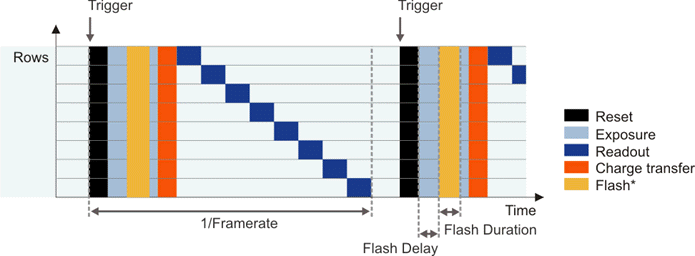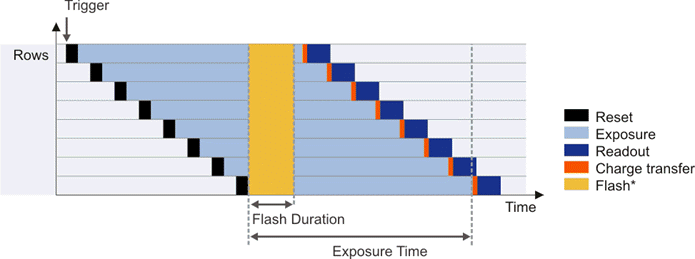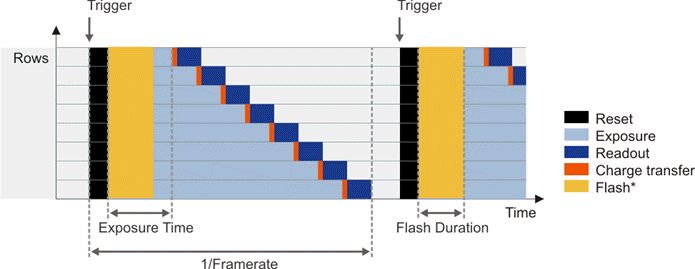IDS Software Suite 4.96.1
|
Note on the schematic diagrams These illustrations show a schematic view of the image capture sequence. The sensor exposure and readout times and the transmission times depend on the camera model and settings. For more information on flash timing see the Digital inputs/outputs chapter. |
General
The image is recorded in the sensor in four phases:
•Reset pixels of the rows to be exposed
•Exposure of pixel rows
•Charge transfer to sensor
•Data readout
The sensor cell must not be exposed during the readout process. The sensors of the uEye cameras have no mechanical shutters, but work with electronic shutter methods instead. Depending on the sensor type, either the rolling shutter method or the global shutter method is used.
On a global shutter sensor, all pixel rows are reset and then exposed simultaneously. At the end of the exposure, all rows are simultaneously moved to a darkened area of the sensor. The pixels are then read out row by row.
Exposing all pixels simultaneously has the advantage that fast-moving objects can be captured without geometric distortions. Sensors that use the global shutter system are more complex in design than rolling shutter sensors.

Fig. 22: Global shutter sensor in live mode

Fig. 23: Global shutter sensor in trigger mode
* Optional flash function. The start time and duration are defined by the flash delay and duration parameters (see also Camera settings: I/O).
With the rolling shutter method, the pixel rows are reset and exposed one row after another. At the end of the exposure, the lines are read out sequentially. As this results in a time delay between the exposure of the first and the last sensor rows, captured images of moving objects are distorted.

Fig. 24: Example for the rolling shutter effect with a moving car
To counteract this effect, the IDS Software Suite provides a global flash window where you set the time by which flash activation is delayed. You can also specify the flash duration. This allows implementing a global flash functionality which exposes all rows of a rolling shutter sensor simultaneously.
Rolling shutter sensors offer a higher pixel density compared to global shutter CMOS sensors. The rolling shutter system is used in uEye cameras with high-resolution CMOS sensors.
|
Some CMOS senors with global shutter can be operated also with rolling shutter. The operation in the rolling shutter mode is used to reduce the image noise. This function is only supported by uEye camera models UI-124x/UI-324x/UI-524x and UI-125x/UI-325x/UI-525x. |

Fig. 25: Rolling shutter sensor in live mode

Fig. 26: Rolling shutter sensor in live mode with global flash window

Fig. 27: Rolling shutter sensor in triggered mode with global flash window
* Optional flash function. The start time and duration are defined by the flash delay and duration parameters (see also Camera settings: I/O).
Rolling shutter with global start
Some rolling shutter sensors also provide a global start mode, which starts exposure of all rows simultaneously (see illustration). For best results, use a flash for this mode. No light is allowed to fall on the sensor outside the flash period because otherwise the image brightness will be distributed unevenly.

Fig. 28: Rolling shutter sensor in trigger mode with global start function
* Optional flash function. The start time and duration are defined by the flash delay and duration parameters (see also Camera settings: I/O).
